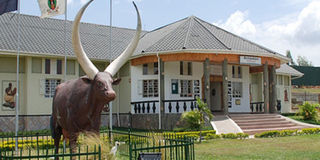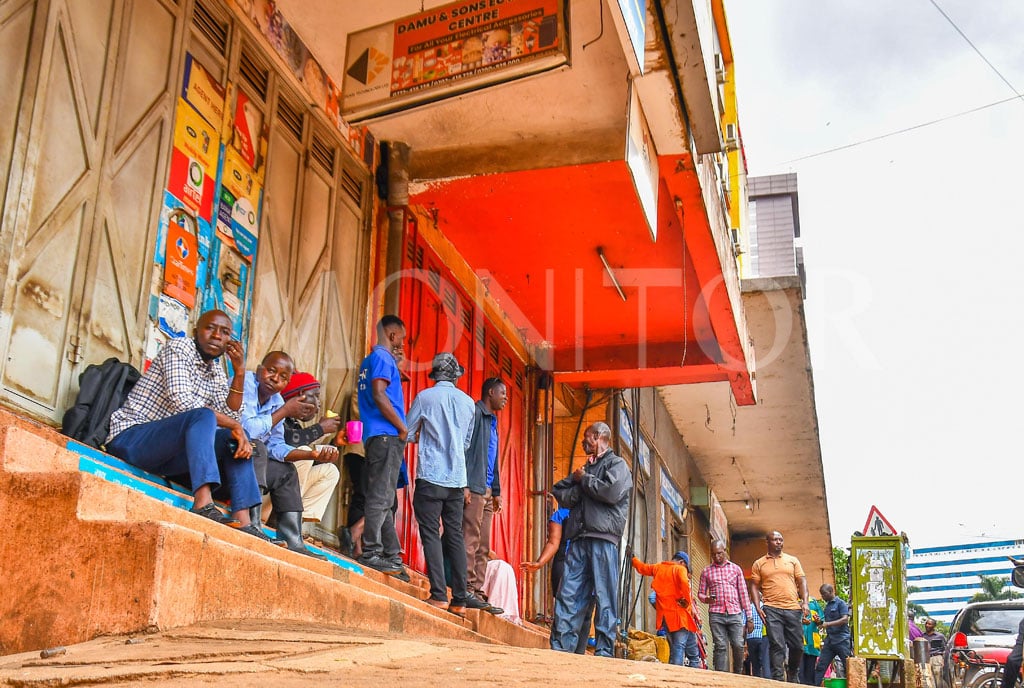The brain behind Igongo Cultural Centre

The Igongo Cultural Centre explores the peoples of south-western Uganda, particularly the Ankole, through artefacts.
What you need to know:
- To curate traditions and histories of a people, one needs an unbroken connection between the present and the past.
- In a perfect world, that unbroken connection is the written records from the past and knowledgeable people such as Eriyazari Bampaire.
Eriyazari Bampaire, 96, is simply awe-inspiring in so many ways. His sense of fashion is as good as his sense of humour. His memory is as shiny as a 19-year-olds which makes him a bridge between the present and the past. It is, therefore, not surprising that when Igongo Cultural Centre was being planned, Bampaire was brought on board as an encyclopedia on what was before what is, and everything in between. The centre is a museum in Mbarara municipality that curates the cultures and history of the people of Western Uganda.
Undiluted information
But in the case of African traditional society, there are no or few written records so the only solution is to search for people from the past whose memory can be relied on. And this is how Bampaire comes into the Igongo story. The cultural centre needed to present the past in a truthful way without first inventing a time machine. Musical instruments, farming and hunting implements, weapons of war, tools used in the production of beer, regalia related to traditional medicine and spirituality, methods of iron smelting and blacksmithing and so on, all needed to be defined and Bampaire was contracted to be a pivotal part of the team that would make this happen.
Birth and education
Bampaire was born five years after World War I, on December 18, 1923 in Kyeizooba, Bushenyi District. His father was a clergyman at the village church and his mother a house wife. He was the sixth out of eight children. He remembers being very eager to learn how to read as a child which should explain why he was sent to the church to do his Kipande in 1939 at tender age of six, when his classmates were much older. Kipande was the word they used for a pre-school course in the alphabet and counting.
His teacher was a young man called Yeremiya Kabutika, who preferred to be called Omusizi, which translates to ‘Planter’ in English. In those days all education was based on the Bible and soon Bampaire was the best Bible reader in class.
He topped his class until the final school term of Primary Four when something peculiar happened. The teacher who had taught him since Primary One was transferred to another school and he was replaced by a new one who immediately started giving Bampaire preferential treatment.
While the former was a strict disciplinarian, the latter was bent on spoiling the brilliant pupil and consequently, young Bampaire failed his exams and was made to repeat Primary Four. Young Bampaire repeated the class with a lot of trepidation and distress. His biggest worry was that he would age in Primary Four which had surprising consequences at the time.
“In those days, if a boy started growing hair on his legs, it was seen as a sign that he was now old enough to start paying taxes and as such would be pulled out of school. This was especially true if the boy in question was not doing very well in class or if he subscribed to a religion opposed to that of the reigning colonial chief,” says Bampaire, “In hindsight, I realise this was a false alarm for I was just 11.”
After this minor bump in Bampaire’s path, he regained his number one spot in class until Junior Three at Mbarara High School. While Bampaire was exceptionally good in all the other subjects, it is his weakness in Arithmetic, Algebra and Geometry that was a thorn in his flesh. He had had a dream of becoming a medical doctor but by Junior Three he knew this would not come easy with his performance in Mathematics. He would have to repeat Junior Four until he passed Mathematics to be able to go to medical school and he would have done just that had his adolescent hormones not conspired against him.
“I did not believe in premarital sex and my body was demanding for it. I had received Christ at the age of 13, and was not about to disobey God and sleep with a woman who was not my wife. If I were to repeat Junior Four until I passed Mathematics, this would prolong the time I would have to wait to get married. I did not see myself waiting that long,”
Marriage
So Bampaire wrote to his father telling him that he wanted to get married. His father wrote back telling him he should stay in school and marry afterwards. So Bampaire joined primary teachers’ college in 1944 after making sure the girl he wanted to marry, Trifine Keneeza, promised to wait for him to finish college and in turn, he would marry her. And true to his word, Bampaire married her on April 18, 1947 shortly after getting a teaching job at Kyeizooba Primary School.

Eriyazari Bampaire during an interview recently. Courtesy Photo
Over the years until he retired in 1978, Bampaire would impart wisdom to thousands of children, many of whom went on to change the world literally. Some of his former students include, Adonia Tiberondwa who went on to become a great politician and minister in Obote’s first presidency, retired Bishops of Ankole Diocese George Tibesigwa and Yona Katooneene of West Ankole Diocese, James Tumusiime, the proprietor of Igongo Cultural Centre and Fountain Publishers.
During his career, he was always responsible for organising Music Dance and Drama concerts and competitions which afforded him meeting so many people both regionally and nationally.
Retirement
After retirement in 1978, Bampaire would go on to serve as the Bushenyi District cultural officer. He would do this till he re-retired to his family home in Kyeizooba in 1993. Sadly his wife passed away in 2009 after 62 years of love and companionship. In 2012, while Bampaire was on the brink of being lost in the troubles of old age after losing his wife, one of his former pupils contacted him to help in the recreation of the past. James Tumusiime was in the process of building the Igongo Museum and he needed Bampaire’s sharp memory. Bampaire went back to work without hesitation and helped create Igongo that is proving to be the pride of the west.
About the centre
Located 12km from Mbarara, this cultural village features the best museum displays in Uganda. Set on the grounds of a former palace of the Ankole king, it explores the people of south-western Uganda, particularly the Banyankole, through artefacts, a cultural village replica and a heap of info. There’s a restaurant serving traditional Ankole dishes, such as smoked Ankole cow’s milk and boiled meats. There’s also a new on-site hotel.
There is a great bookshop with an interesting selection of Ugandan reading material. Directly across from the centre is Biharwe Eclipse Monument atop Biharwe Hill. It was built to commemorate a victory for Ankole kingdom 500 years ago, following an eclipse that saw the invading king retreat in fear (and never return), spooked as day plunged into sudden darkness.




